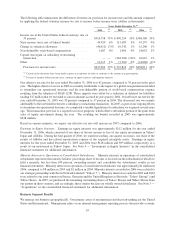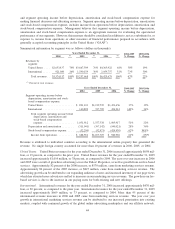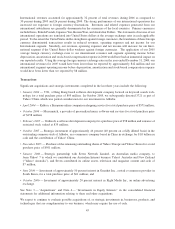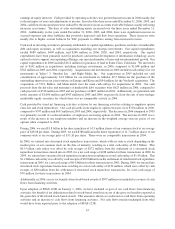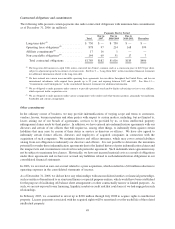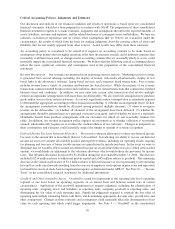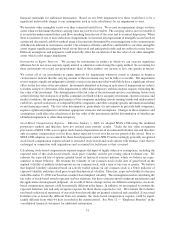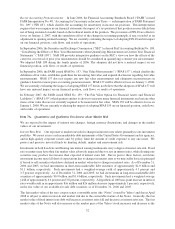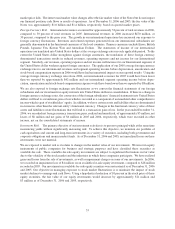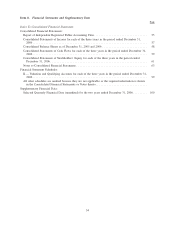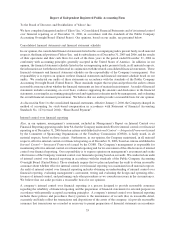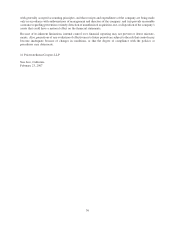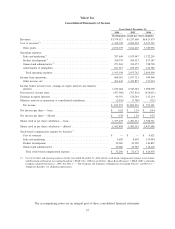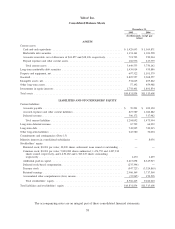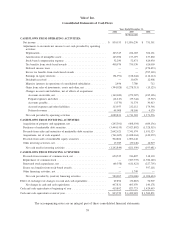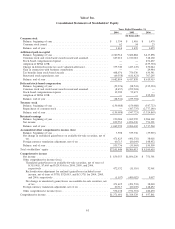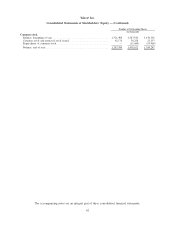Yahoo 2006 Annual Report Download - page 62
Download and view the complete annual report
Please find page 62 of the 2006 Yahoo annual report below. You can navigate through the pages in the report by either clicking on the pages listed below, or by using the keyword search tool below to find specific information within the annual report.Recent Accounting Pronouncements. In June 2006, the Financial Accounting Standards Board (“FASB”) issued
FASB Interpretation No. 48, “Accounting for Uncertainty in Income Taxes — an Interpretation of FASB Statement
No. 109” (“FIN 48”), which clarifies the accounting for uncertainty in income tax positions. This Interpretation
requires that we recognize in our financial statements the impact of a tax position if that position is more likely than
not of being sustained on audit, based on the technical merits of the position. The provisions of FIN 48 are effective
for us on January 1, 2007, with the cumulative effect of the change in accounting principle, if any, recorded as an
adjustment to opening retained earnings. We are currently evaluating the impact of adopting FIN 48 and its impact
on our financial position, cash flows, and results of operations.
In September 2006, the Securities and Exchange Commission (“SEC”) released Staff Accounting Bulletin No. 108,
“Considering the Effects of Prior Year Misstatements when Quantifying Misstatements in Current Year Financial
Statements” (“SAB 108”). SAB 108 provides interpretive guidance on the SEC’s views on how the effects of the
carryover or reversal of prior year misstatements should be considered in quantifying a current year misstatement.
We adopted SAB 108 during the fourth quarter of 2006. The adoption did not have a material impact on our
financial position, cash flows or results of operations.
In September 2006, the FASB issued SFAS No. 157, “Fair Value Measurements” (“SFAS 157”), which clarifies the
definition of fair value, establishes guidelines for measuring fair value, and expands disclosures regarding fair value
measurements. SFAS 157 does not require any new fair value measurements and eliminates inconsistencies in
guidance found in various prior accounting pronouncements. SFAS 157 will be effective for us on January 1, 2008.
We are currently evaluating the impact of adopting SFAS 157 but do not believe that the adoption of SFAS 157 will
have any material impact on our financial position, cash flows, or results of operations.
In February 2007, the FASB issued SFAS No. 159, “The Fair Value Option for Financial Assets and Financial
Liabilities” (“SFAS 159”) which permits entities to choose to measure many financial instruments and certain other
items at fair value that are not currently required to be measured at fair value. SFAS 159 will be effective for us on
January 1, 2008. We are currently evaluating the impact of adopting SFAS 159 on our financial position, cash flows,
and results of operations.
Item 7A. Quantitative and Qualitative Disclosures about Market Risk
We are exposed to the impact of interest rate changes, foreign currency fluctuations, and changes in the market
values of our investments.
Interest Rate Risk. Our exposure to market rate risk for changes in interest rates relates primarily to our investment
portfolio. We invest excess cash in marketable debt instruments of the United States Government and its agencies,
and in high-quality corporate issuers and, by policy, limit the amount of credit exposure to any one issuer. We
protect and preserve invested funds by limiting default, market and reinvestment risk.
Investments in both fixed rate and floating rate interest earning instruments carry a degree of interest rate risk. Fixed
rate securities may have their fair market value adversely impacted due to a rise in interest rates, while floating rate
securities may produce less income than expected if interest rates fall. Due in part to these factors, our future
investment income may fall short of expectations due to changes in interest rates or we may suffer losses in principal
if forced to sell securities which have declined in market value due to changes in interest rates. As of December 31,
2006 and 2005, we had investments in short-term marketable debt securities of approximately $1.0 billion and
$1.1 billion, respectively. Such investments had a weighted-average yield of approximately 4.3 percent and
3.5 percent, respectively. As of December 31, 2006 and 2005, we had investments in long-term marketable debt
securities of approximately $0.9 billion and $1.4 billion, respectively. Such investments had a weighted average
yield of approximately 4.6 percent and 3.8 percent, respectively. A hypothetical 100 basis point increase in interest
rates would result in an approximate $16 million and $26 million decrease (approximately 1 percent), respectively,
in the fair value of our available-for-sale debt securities as of December 31, 2006 and 2005.
The fair market value of the zero coupon senior convertible notes (the “Notes”) issued by Yahoo! and due in April
2008 is subject to interest rate risk and market risk due to the convertible feature of the Notes. Generally, the fair
market value of fixed interest rate debt will increase as interest rates fall and decrease as interest rates rise. The fair
market value of the Notes will also increase as the market price of the Yahoo! stock increases and decrease as the
52



